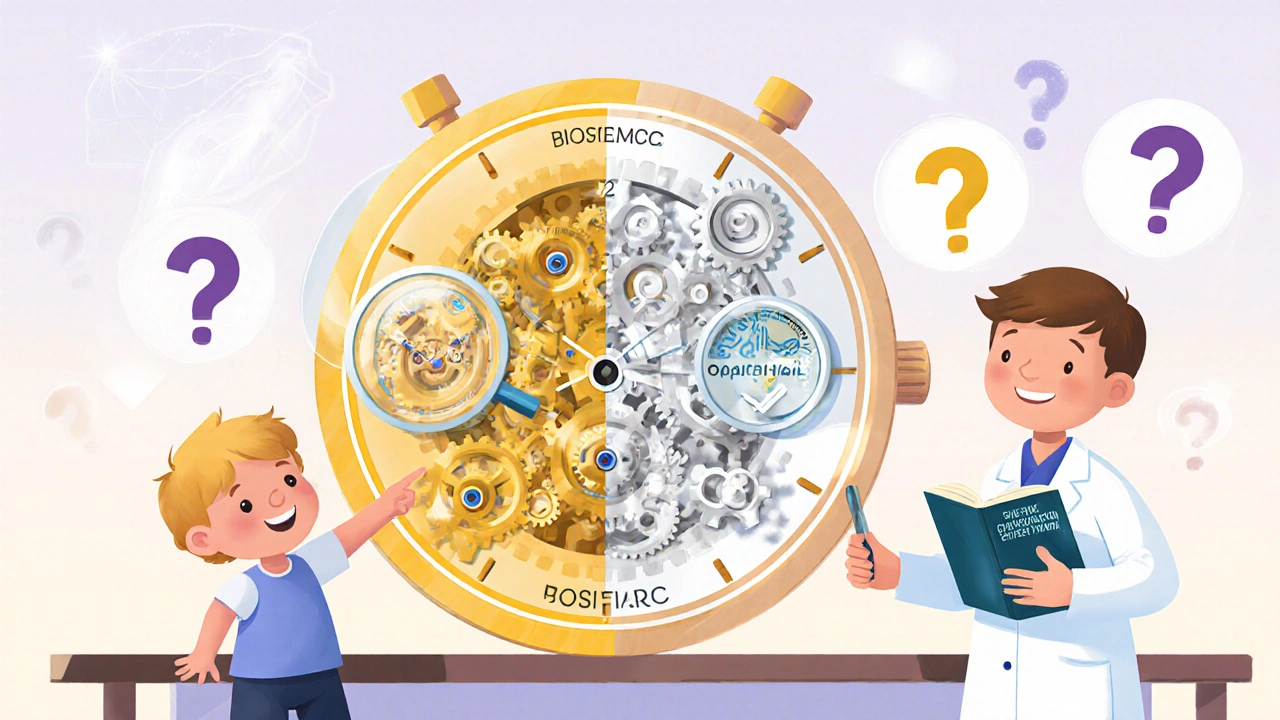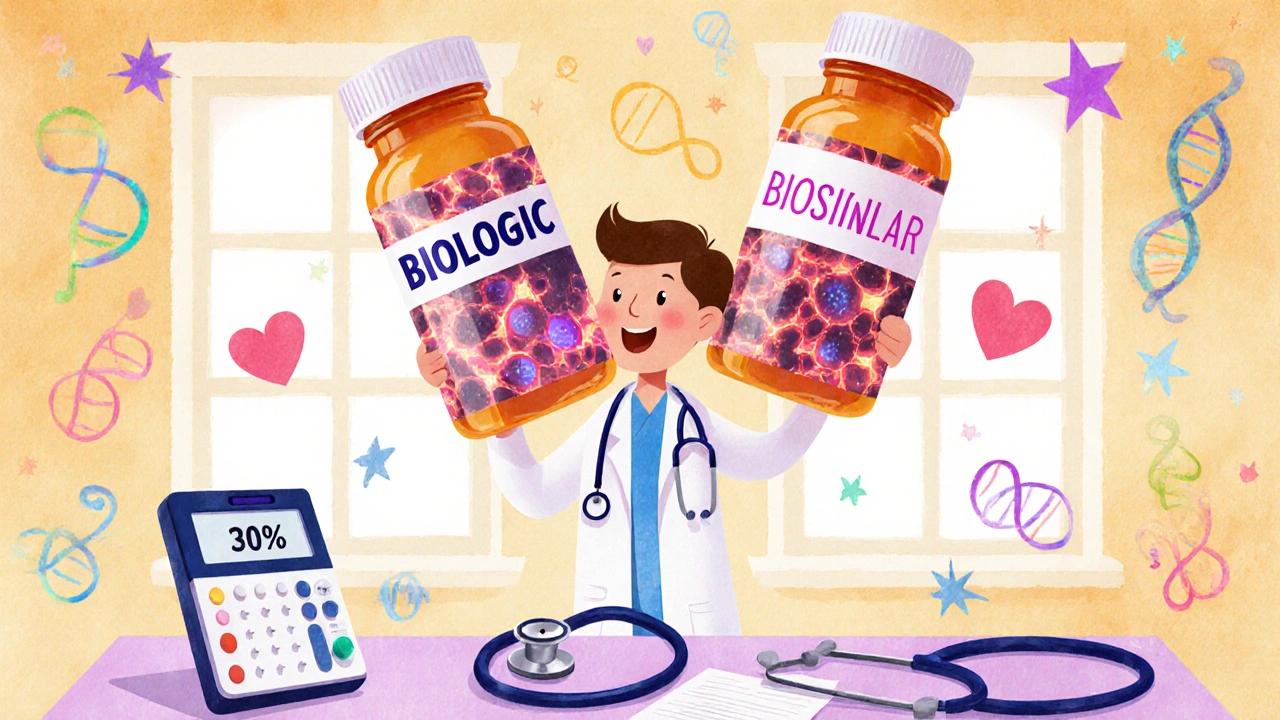When a doctor prescribes a biologic for rheumatoid arthritis, Crohn’s disease, or cancer, they’re using a complex, living-cell-derived medicine that can cost tens of thousands of dollars a year. Now imagine a version of that same drug-nearly identical in structure and effect-that costs 30% less. That’s a biosimilar. But here’s the problem: many providers still don’t understand how biosimilars are different from generics, and that gap is costing patients access and trust.
What Exactly Is a Biosimilar?
A biosimilar is not a copy. It’s not a generic. It’s a highly similar version of a biologic drug that’s been approved by the FDA after proving it has no clinically meaningful difference in safety, purity, or potency compared to the original product. The reference biologic could be Humira, Enbrel, or Herceptin-drugs made from living cells, not chemicals. Because they come from living systems, even tiny changes in manufacturing can affect how they behave in the body. That’s why biosimilars require more than just a chemical test to prove they work the same.
The FDA requires biosimilars to go through a rigorous process: thousands of analytical tests, animal studies, and at least one clinical trial showing they perform the same in humans. This isn’t like generics, where a pill’s active ingredient just needs to match the original in absorption rate. Biosimilars are like a hand-crafted replica of a Swiss watch-every gear must fit, even if it’s made by a different craftsman.
Biosimilars vs Generics: The Critical Difference
Let’s clear up the biggest confusion: biosimilars are not generics. Generics are chemically identical to their brand-name counterparts. They’re made from simple molecules, like aspirin or metformin. You can synthesize them in a lab using predictable chemical reactions. That’s why a generic version of Lipitor looks and acts exactly like the original.
Biosimilars? They’re made from living cells-human or animal-and even small changes in the cell line, temperature, or purification process can create minor structural variations. These differences don’t affect safety or effectiveness, but they do mean you can’t say they’re “identical.” The FDA calls them “highly similar,” not “the same.”
Here’s the real-world impact: 63% of U.S. physicians in a 2016 survey couldn’t correctly identify this distinction. That’s not just a knowledge gap-it’s a barrier to adoption. Providers who think biosimilars are “cheap generics” may hesitate to prescribe them, even when they’re the best option.
Why Should Providers Care About Biosimilars?
Because they’re changing how care is delivered-and saving money, big time. The Congressional Budget Office estimates biosimilars could save the U.S. healthcare system $150 billion over the next decade. Medicare Part B data from 2022 shows biosimilars are already priced 28% lower than their reference biologics. That’s not a small discount. That’s enough to cover months of treatment for patients who otherwise can’t afford it.
But cost isn’t the only reason. In Europe, where biosimilar education has been strong for over a decade, 80% of eligible biologic prescriptions are filled with biosimilars. In the U.S., that number is still only 32%. Why the gap? Education. Providers who’ve been trained on biosimilars are 92% confident in their efficacy. Those who haven’t? Only 40.1% feel confident. That’s a 52-point difference in trust.

Where the Confusion Comes From: Immunogenicity, Extrapolation, and Interchangeability
Three concepts trip up even experienced clinicians.
Immunogenicity-the risk that the body will react to the drug as a foreign invader-is a real concern with biologics. Biosimilars must prove their immunogenicity profile is comparable to the reference product. Minor differences in inactive ingredients (like stabilizers or preservatives) can exist, but they’re tested to ensure they don’t increase immune reactions. Still, many providers worry about switching patients from the original to a biosimilar. The data says: no increased risk. Multiple studies, including those from the Arthritis Foundation, show no difference in antibody formation between biosimilars and originators.
Extrapolation is when a biosimilar is approved for multiple uses based on data from just one condition. For example, if a biosimilar is tested in rheumatoid arthritis and performs the same as the reference drug, the FDA can approve it for psoriatic arthritis, Crohn’s, and ankylosing spondylitis-even if it wasn’t tested in those exact conditions. Why? Because the mechanism of action is the same. But 57% of providers still express concern about this. They think, “If it wasn’t tested in my patient’s condition, is it safe?” The answer, backed by 37 clinical trials involving over 12,500 patients, is yes.
Interchangeability is a separate designation. Not all biosimilars are interchangeable. Only those that have passed additional studies proving patients can switch back and forth between the biosimilar and the reference product multiple times without loss of safety or effectiveness. In states that allow automatic substitution, pharmacists can switch a patient’s prescription without asking the doctor-but only if the biosimilar has this designation. As of 2023, only a handful of biosimilars have received this status in the U.S.
Who’s Leading in Adoption-and Who’s Falling Behind
Adoption isn’t even across specialties. Rheumatologists are the most comfortable, with 68% prescribing biosimilars regularly. Oncologists follow at 52%. Why? Because they’ve seen the data. In cancer care, every dollar saved means more patients can get treatment. One study at UCSF Medical Center showed that after pharmacist-led education, provider hesitancy dropped from 58% to 12% in just six months.
Endocrinologists? Only 29%. Even though insulin biosimilars have been available since 2015, uptake is slow. Why? A mix of unfamiliarity, patient fear, and EHR systems that don’t track biosimilars properly. In fact, 78% of U.S. hospitals report challenges documenting biosimilar use in electronic records. Some systems still lump them under the reference product name, making it impossible to track outcomes or billing correctly.

What Education Actually Works
Training isn’t one-size-fits-all. The FDA’s Teaching Resource Guide includes 12 modules, free and available in nine languages. But studies show that passive reading isn’t enough. The most effective programs are hands-on, specialty-specific, and led by clinical pharmacists.
At the University of Pittsburgh Medical Center, they used a three-phase approach:
- Foundational knowledge (4 weeks): What biosimilars are, how they’re made, FDA requirements.
- Specialty application (6 weeks): Case studies for oncology, rheumatology, endocrinology.
- Implementation support (ongoing): Pharmacists on rounds, EHR troubleshooting, real-time Q&A.
Within six months, 89% of providers felt confident using biosimilars. Compare that to the 40.1% baseline. That’s the power of structured, practical education.
Pharmacists are the unsung heroes here. In 76% of hospitals, pharmacists lead biosimilar education. They know the billing codes, the EHR quirks, and how to explain differences to patients. They’re the bridge between science and practice.
What Providers Still Don’t Know
Here’s what’s still missing from most training:
- How to explain biosimilars to patients without causing fear. Patients hear “copy” and think “inferior.”
- How to handle state-specific substitution laws. Forty-two states have laws allowing substitution, but rules vary. Some require notice to the prescriber within 24 hours. Others don’t require any.
- How to track biosimilar outcomes in real-world settings. The FDA is adding more real-world evidence content to its 2024 update because 73% of providers say they need it.
And here’s the kicker: younger providers are less familiar than older ones. Dr. Andrew Kusmierczyk’s research found that providers under 35 have 40% lower familiarity with biosimilars than those over 50. That’s not because they’re less capable-it’s because they weren’t taught this in school. Medical and pharmacy curricula are only now starting to include biosimilars. By 2025, 95% of U.S. medical schools plan to integrate them into training.
What You Can Do Today
You don’t need to wait for a formal training program. Start here:
- Visit the FDA’s Teaching Resource Guide-it’s free, comprehensive, and updated regularly.
- Ask your pharmacy department if they offer biosimilar education. If not, suggest it.
- Learn your state’s substitution laws. The National Conference of State Legislatures has a public database.
- Practice explaining the difference between biosimilars and generics to a colleague. If you can’t do it in two sentences, you’re not ready to explain it to a patient.
- Check your EHR. Can you tell if a patient received a biosimilar or the reference product? If not, push for a fix.
Every provider who understands biosimilars becomes a force multiplier. They help patients get affordable care. They reduce system waste. They build trust in science.
It’s not about replacing biologics. It’s about expanding access without sacrificing safety. And that’s something every clinician should be equipped to do.
Are biosimilars the same as generic drugs?
No. Generics are chemically identical copies of small-molecule drugs, like aspirin or metformin. Biosimilars are highly similar versions of complex biologic drugs made from living cells. They require extensive testing to prove they work the same way, but they’re not identical. Minor differences in structure are allowed as long as they don’t affect safety or effectiveness.
Can biosimilars be substituted automatically at the pharmacy?
Only if they’re designated as “interchangeable” by the FDA. Not all biosimilars have this status. Even then, substitution rules vary by state. Forty-two U.S. states allow substitution, but some require the prescriber to be notified, while others don’t. Always check your state’s laws before switching.
Why do some providers hesitate to prescribe biosimilars?
Common concerns include fear of reduced effectiveness, uncertainty about extrapolation (using data from one condition to approve another), and confusion over immunogenicity risks. Many also worry about EHR documentation and patient confusion. But studies show that after education, provider confidence jumps from 40% to over 90%. The data supports biosimilars-they’re safe and effective.
How much money can biosimilars save?
The Congressional Budget Office estimates biosimilars could save the U.S. healthcare system $150 billion over the next decade. In Medicare Part B, biosimilars are already priced 28% lower than their reference biologics. In Europe, where adoption is higher, savings have reached 60% for some products.
Which specialties are using biosimilars the most?
Rheumatologists lead at 68% adoption, followed by oncologists at 52%. Endocrinologists lag behind at 29%, even though insulin biosimilars have been available since 2015. The gap comes down to education, EHR support, and patient communication-not safety concerns.
Where can I find reliable biosimilar education resources?
The FDA’s Office of Therapeutic Biologics and Biosimilars offers a free, comprehensive Teaching Resource Guide with 12 modules in nine languages. It’s designed for clinicians, pharmacists, and nurses. The Arthritis Foundation and the Alliance for Safe Biologic Medicines also offer free provider toolkits with case studies and patient communication guides.



Comments (15)
Bea Rose
Biosimilars aren't generics. That's it. Stop treating them like they are.
Vanessa Carpenter
I've seen so many patients panic when they hear 'biosimilar'-like it's a knockoff iPhone. But once you sit down with them and explain it's like a different brand of aspirin, not a fake one, they calm right down. It's all in how you frame it.
Wendy Edwards
My grandma got her biosimilar for RA last year and saved like $4k a year. She still thinks it's 'the same stuff' and doesn't care what the FDA says as long as it works. Honestly? That's the real win here-patients getting care they couldn't afford before. Stop overcomplicating it for them.
stephen riyo
Wait, so you're telling me... that if I switch my patient from Humira to a biosimilar... they might... have a different... immune response...? But the data says no? But what if...? I mean, I've seen things... in the ER... and... I just... I need to know... for sure... I mean, what if...?
Shannon Amos
So let me get this straight: we spent 20 years telling doctors generics are just as good, and now we're saying biosimilars are just as good... but we're acting like they're magic unicorn pills? Yeah, sure. Tell that to the pharmacist who's been pushing this since 2015 and got ignored.
Mqondisi Gumede
Why are we even talking about this? America spends more on healthcare than any country and still can't get people to take cheaper meds? This isn't science-it's capitalism. Let the rich keep their $20k biologics. The rest of us will take the biosimilars and live longer anyway
Amanda Meyer
The data is clear, but the psychological barrier remains. Providers aren't resisting science-they're resisting uncertainty. And when your liability insurance is on the line, 'highly similar' doesn't feel like enough. We need standardized, specialty-specific training-not just PDFs. We need mentorship, case rounds, peer-to-peer validation. That’s what changes behavior.
Jesús Vásquez pino
My clinic just rolled out a pharmacist-led biosimilar education hour every other Thursday. We do one case, one EHR fix, one patient script. In three months, we went from 18% adoption to 63%. It’s not about being smarter-it’s about being supported. Pharmacists are the MVPs here. Let them lead.
Dan Rua
Just had a patient ask me if biosimilars were 'like generic insulin.' I smiled and said, 'Think of it like two different brands of peanut butter. Same ingredients, same nutrition, different jar.' They laughed and said, 'Then why’s one $200?' I said, 'Because someone spent $10 billion marketing the other one.' They got it. Simple works.
Jaspreet Kaur
Science is not about certainty but about confidence built over time. The watchmaker may change but the gears still turn. The body does not know the brand. It knows the effect. We are afraid not because of data but because we were taught to fear what we cannot perfectly control
vikas kumar
My med school didn’t mention biosimilars once. I learned it from a pharmacist on night shift. That’s the problem. We’re training future doctors on outdated models. If we don’t fix the curriculum, we’re just delaying the inevitable. By 2025, this’ll be common sense. Why are we still arguing about it in 2025?
Gina Banh
Let’s be real-most providers don’t care about the science. They care about their EHR auto-populating the wrong code. They care about their billing getting denied. They care about their patient calling the office because the pill looks different. Fix the system first. The education will follow. Stop putting the burden on the clinician to be a biochemist.
hannah mitchell
I’ve been prescribing biosimilars for two years. My patients don’t notice the difference. My billing team finally figured out the coding. My EHR still lumps them under the brand name. I just keep doing it. It’s the right thing. Sometimes that’s enough.
Michael Collier
It is imperative that the medical community recognize that the adoption of biosimilars is not merely a pharmacoeconomic imperative but a moral one. The disparity in access to life-sustaining biologics constitutes a systemic inequity that can be mitigated through evidence-based education, standardized institutional protocols, and collaborative interprofessional engagement. The data are unequivocal. The time for hesitation has elapsed.
Cynthia Boen
Why are we even doing this? Just let the market decide. If patients want the expensive one, they’ll pay for it. Stop forcing biosimilars down everyone’s throat. Not everyone wants to be a guinea pig.